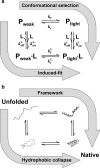Unified understanding of folding and binding mechanisms of globular and intrinsically disordered proteins
- PMID: 29307002
- PMCID: PMC5899706
- DOI: 10.1007/s12551-017-0346-7
Unified understanding of folding and binding mechanisms of globular and intrinsically disordered proteins
Abstract
Extensive experimental and theoretical studies have advanced our understanding of the mechanisms of folding and binding of globular proteins, and coupled folding and binding of intrinsically disordered proteins (IDPs). The forces responsible for conformational changes and binding are common in both proteins; however, these mechanisms have been separately discussed. Here, we attempt to integrate the mechanisms of coupled folding and binding of IDPs, folding of small and multi-subdomain proteins, folding of multimeric proteins, and ligand binding of globular proteins in terms of conformational selection and induced-fit mechanisms as well as the nucleation-condensation mechanism that is intermediate between them. Accumulating evidence has shown that both the rate of conformational change and apparent rate of binding between interacting elements can determine reaction mechanisms. Coupled folding and binding of IDPs occurs mainly by induced-fit because of the slow folding in the free form, while ligand binding of globular proteins occurs mainly by conformational selection because of rapid conformational change. Protein folding can be regarded as the binding of intramolecular segments accompanied by secondary structure formation. Multi-subdomain proteins fold mainly by the induced-fit (hydrophobic collapse) mechanism, as the connection of interacting segments enhances the binding (compaction) rate. Fewer hydrophobic residues in small proteins reduce the intramolecular binding rate, resulting in the nucleation-condensation mechanism. Thus, the folding and binding of globular proteins and IDPs obey the same general principle, suggesting that the coarse-grained, statistical mechanical model of protein folding is promising for a unified theoretical description of all mechanisms.
Keywords: Conformational selection; Induced-fit; Intrinsically disordered protein; Ligand binding; Nucleation–condensation; Protein folding.
Conflict of interest statement
Funding
This study was funded by Grants-in-Aids for Scientific Research from the Ministry of Education, Culture, Sports, Science and Technology (MEXT).
Conflict of interest
Munehito Arai declares that he has no conflict of interest.
Ethical approval
This article does not contain any studies with human participants or animals performed by the author.
Figures





Similar articles
-
Conformational propensities of intrinsically disordered proteins influence the mechanism of binding and folding.Proc Natl Acad Sci U S A. 2015 Aug 4;112(31):9614-9. doi: 10.1073/pnas.1512799112. Epub 2015 Jul 20. Proc Natl Acad Sci U S A. 2015. PMID: 26195786 Free PMC article.
-
The binding mechanisms of intrinsically disordered proteins.Phys Chem Chem Phys. 2014 Apr 14;16(14):6323-31. doi: 10.1039/c3cp54226b. Epub 2013 Dec 6. Phys Chem Chem Phys. 2014. PMID: 24317797
-
Templated folding of intrinsically disordered proteins.J Biol Chem. 2020 May 8;295(19):6586-6593. doi: 10.1074/jbc.REV120.012413. Epub 2020 Apr 6. J Biol Chem. 2020. PMID: 32253236 Free PMC article. Review.
-
Synergistic folding of two intrinsically disordered proteins: searching for conformational selection.Mol Biosyst. 2012 Jan;8(1):198-209. doi: 10.1039/c1mb05156c. Epub 2011 Jul 18. Mol Biosyst. 2012. PMID: 21766125
-
Dynamics and interactions of intrinsically disordered proteins.Curr Opin Struct Biol. 2024 Feb;84:102734. doi: 10.1016/j.sbi.2023.102734. Epub 2023 Nov 30. Curr Opin Struct Biol. 2024. PMID: 38039868 Review.
Cited by
-
Discovery of Indole-Thiourea Derivatives as Tyrosinase Inhibitors: Synthesis, Biological Evaluation, Kinetic Studies, and In Silico Analysis.Int J Mol Sci. 2024 Sep 5;25(17):9636. doi: 10.3390/ijms25179636. Int J Mol Sci. 2024. PMID: 39273583 Free PMC article.
-
Identification of non-conserved residues essential for improving the hydrocarbon-producing activity of cyanobacterial aldehyde-deformylating oxygenase.Biotechnol Biofuels. 2019 Apr 17;12:89. doi: 10.1186/s13068-019-1409-8. eCollection 2019. Biotechnol Biofuels. 2019. PMID: 31015863 Free PMC article.
-
The Wako-Saitô-Muñoz-Eaton Model for Predicting Protein Folding and Dynamics.Molecules. 2022 Jul 12;27(14):4460. doi: 10.3390/molecules27144460. Molecules. 2022. PMID: 35889332 Free PMC article. Review.
-
Multivalency enables unidirectional switch-like competition between intrinsically disordered proteins.Proc Natl Acad Sci U S A. 2022 Jan 18;119(3):e2117338119. doi: 10.1073/pnas.2117338119. Proc Natl Acad Sci U S A. 2022. PMID: 35012986 Free PMC article.
-
Synergies of Single Molecule Fluorescence and NMR for the Study of Intrinsically Disordered Proteins.Biomolecules. 2021 Dec 24;12(1):27. doi: 10.3390/biom12010027. Biomolecules. 2021. PMID: 35053175 Free PMC article. Review.
References
-
- Akiyama S, Takahashi S, Ishimori K, Morishima I. Stepwise formation of α-helices during cytochrome c folding. Nat Struct Biol. 2000;7:514–520. - PubMed
-
- Arai M, Hamel P, Kanaya E, Inaka K, Miki K, Kikuchi M, Kuwajima K. Effect of an alternative disulfide bond on the structure, stability, and folding of human lysozyme. Biochemistry. 2000;39:3472–3479. - PubMed
Publication types
LinkOut - more resources
Full Text Sources
Other Literature Sources

